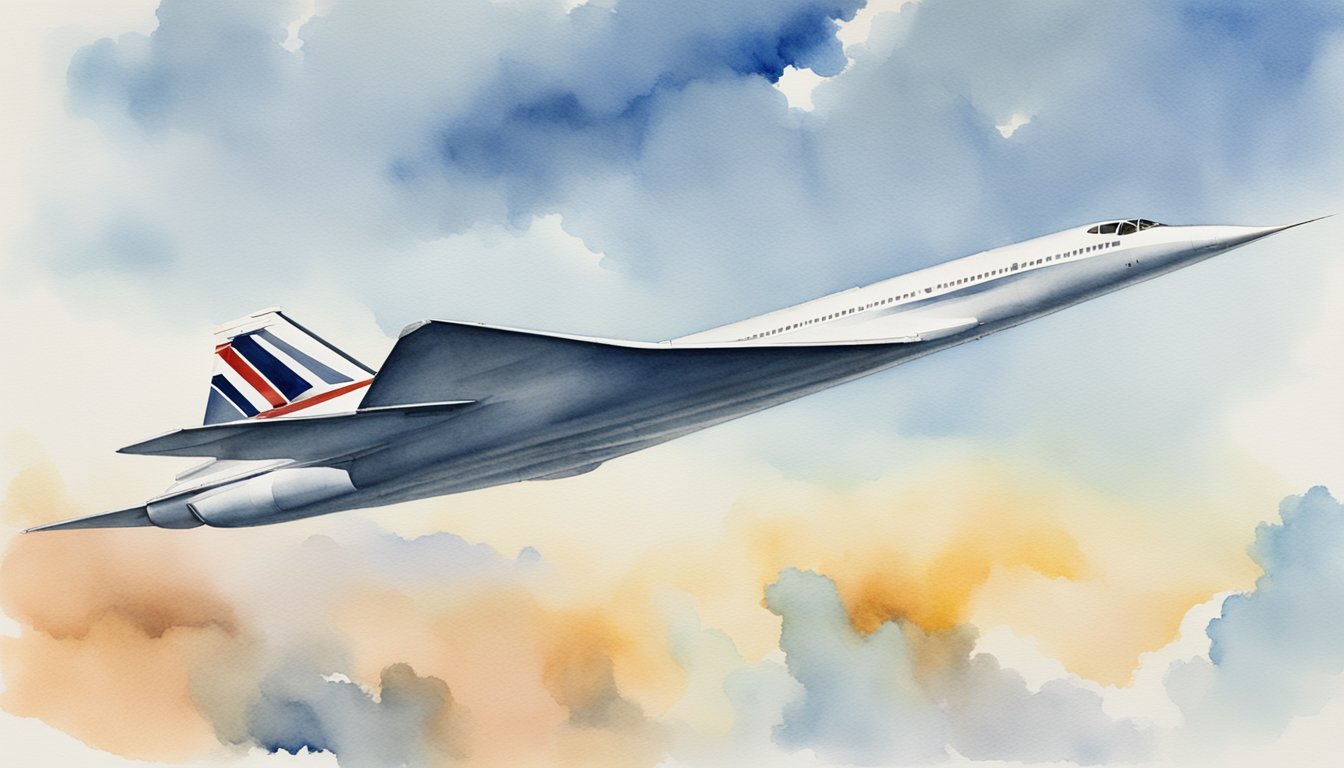Historical Overview of Concorde

Concorde, the legendary supersonic passenger jet, soared through the aviation world from its first flight in the skies of France and the United Kingdom to its memorable services across the Atlantic. This jet’s journey is a tapestry of groundbreaking engineering, luxury, and speed.
Inception and Development
Concorde’s story began with a collaboration between France and the United Kingdom, leading to its sleek delta-wing design and iconic pointed nose. British Airways and Air France became the flag carriers of this supersonic aircraft, which promised to shrink the world travel map significantly. It performed its first flight in 1969, showcasing the height of aviation technology and a symbol of national pride for both countries.
Pinnacle of Service and Notable Routes
During its prime, Concorde became synonymous with luxury and speed, whisking passengers from London Heathrow to New York’s JFK in under four hours. Other notable routes included Paris to Rio de Janeiro, Miami, Caracas, and even a unique service connecting Bahrain to Singapore. Its operation was not just a testament to speed but also luxury, attracting notable passengers such as renowned cellist Mstislav Rostropovich.
Retirement and Legacy
The inevitable retirement of Concorde in 2003 followed economic challenges and the unfortunate incident of Air France Flight 4590, taking off from Charles de Gaulle Airport. Its retirement ended the era of commercial supersonic travel, leaving a legacy that can be revisited at institutions like the National Air and Space Museum in Washington D.C. Future prospects like Boom Supersonic aim to revive supersonic travel, honoring Concorde’s pioneering influence in aviation history.
Experience and Costs of Flying Concorde
The iconic Concorde jet, known for its supersonic speeds, provided passengers with unparalleled luxury and swift transatlantic flights. However, extravagance came at a high cost, both for consumers in ticket prices and for carriers in operating expenses.
Luxury Features and Amenities
Concorde’s luxury was legendary, offering amenities that went well above those of standard first-class service on commercial aircraft. Passengers were treated to sumptuous meals featuring gourmet selections like champagne, caviar, and lobster. The level of comfort stretched beyond the dining experience; the cabin was meticulously designed to make the swift journey across the Atlantic as pleasant as possible. Aviation enthusiasts and executives often chose Concorde not just for its speed, which could reach Mach 2, cutting flight time significantly, but also for the upscale experience that made flying feel more like an indulgent celebration than mere transportation.
Ticket Prices and Demand Factors
Reflecting the luxury service and speed, Concorde’s ticket prices were substantially higher than those of standard first-class transatlantic flights. A round-trip flight could cost several times the price of a regular first-class ticket, driven by factors including the high operating costs of supersonic flights and the aircraft’s limited capacity. Demand for this premium service largely came from the wealthiest passengers and corporate executives who valued time savings and exclusivity. Despite the hefty price tag, there was often high demand for the experience of traveling faster than sound over the Atlantic. The influence of ticket pricing on demand was clearly noticed; many people with Concorde experience expressed a desire to fly again, albeit with the cost consideration in mind, reflecting the aircraft’s allure to a very specific market.
Technical Aspects and Aviation Milestones

The Concorde, a marvel of engineering, redefined what commercial aviation could achieve with its ability to cruise at twice the speed of sound. This feat, along with its distinctive design characterized by a droop nose, made it a symbol of luxury and technological innovation.
Speed and Engineering Innovations
At the heart of Concorde’s advancements was its capability to reach speeds over Mach 2.04, pushing it beyond the sonic barrier and into history books. It was propelled by powerful afterburners, typically reserved for fighter jets, enabling it to cut transatlantic flight times in half and thus creating an entirely new market of time-sensitive travelers. The aircraft’s engineering also featured an iconic droop nose design, allowing pilots to improve visibility during takeoff and landing, while maintaining an aerodynamic shape in cruise.
The Concorde was engineered for the skies with remarkable technical prowess, manifesting the limits of supersonic commercial aircraft value and viability.
Operational Challenges and Achievements
Operating the Concorde was a challenging task, with high operating costs due to intense fuel consumption and maintenance requirements. The aircraft’s sonic boom limited its supersonic travel to oceanic routes, avoiding noise issues over populated areas. Despite these challenges, Concorde remained a symbol of exclusivity and luxury, catering to celebrities and the business elite. Airlines like Singapore Airlines, Braniff International, and American Airlines utilized the aircraft to connect key cities like New York JFK, Dallas Fort Worth, and Washington Dulles at unprecedented speeds.
After an unfortunate crash and the associated downturn in the global aviation market, the Concorde was retired in 2003, making its last commercial flight an event of bittersweet finality. Since then, it has transitioned from a symbol of commercial flight to a museum piece, securing its place as an icon of a bygone era. Memorabilia and artifacts from the Concorde era, including uniforms worn by the flight attendants, are highly prized by collectors and aviation enthusiasts, attesting to the aircraft’s lasting impact on commercial aviation and its impressive legacy.

